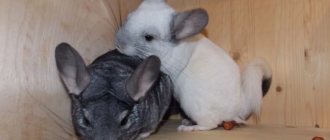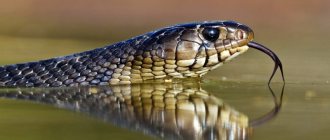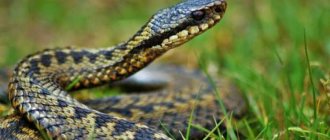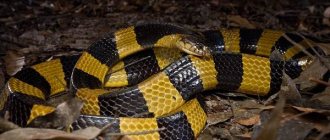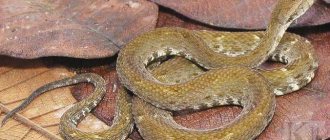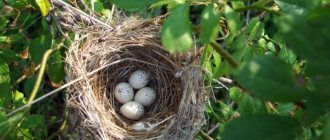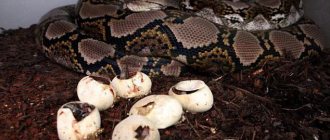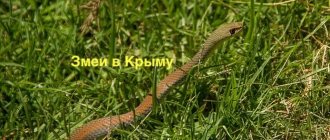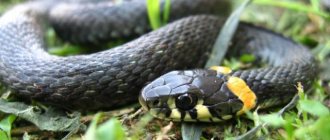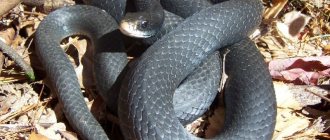Almost all snakes reproduce sexually. Only certain species have the ability to parthenogenesis. Reproduction is carried out without the participation of a male. A rare exception are hermaphrodite snakes. These individuals act as males in some cases, and as females in others. The existence of such snakes in nature is quite effective for the species as a whole. In most species, distinguishing a female from a male is quite difficult. Among the visible differences, body size can be noted. Male snakes are usually larger than females.
Features of the structure of males and females
It is almost impossible to determine the sex of a snake by external signs. It can only be assumed based on certain features: females are usually shorter and smaller than males (except for boa constrictors), males have a brighter color.
The male is usually larger than the female and has a brighter color
However, you should not rely on this method, since these signs are too relative. The sexual characteristics of reptiles are hidden from prying eyes. Males have paired hemipenises, and females have paired hemiclitoris, which are located inside the body and are not visible externally.
When there is a female specimen nearby that is capable of fertilization, the male’s genitals enlarge and appear from the abdominal part of the body, closer to the tail. Only one of the hemipenes is involved in the mating process.
Important! During the breeding season, reptiles become more aggressive, so meeting them can be dangerous.
A female ready for mating secretes a special secretion, the smell of which males can smell from several kilometers away. It is he who attracts males.
Tip #1. When going to the forest or other habitat of snakes in the spring - during the breeding season, you should be especially careful. At this time, reptiles can become aggressive.
Place of masonry
For any female, eggs are the most valuable thing she has. And snakes are no exception. Therefore, the place for laying is chosen to be quiet, safe and as comfortable as possible. Steppe snakes often live in burrows and hide their clutches there. Forest ones do this under snags, and desert ones often bury them in the sand. It all depends on the environment and living conditions.
Females usually protect their offspring, warming them through active contraction of the body muscles until they are born. It is difficult to call snakes caring parents; the cubs show independence literally from the first minutes of life, obtaining food for themselves and not relying on adults. In some species, the male is responsible for the safety of the nest, and sometimes the parents take turns guarding it.
Snake Reproduction - Mating
Mating occurs in the spring, after hibernation. Male representatives of reptiles are the first to crawl out of their lair. They warm up in the sun and look for food. Females, having not yet left their winter shelter, are already beginning to emit a smell indicating their readiness for copulation.
Males, fighting for the female, try to rise as high as possible
Males, attracted by the smell, compete with each other, try to drive away rivals, engaging in a kind of battle with them. They wrap themselves around each other, push each other and try to rise above the others. As a result, the defeated contender retreats on his own, and the winner begins the mating dance.
He crawls next to the female and presses against her. Males of some species can be quite aggressive and even bite their chosen one. Their task is to force the female to open access to the cloaca. Once this is achieved, the male snake plunges one of the hemipenes into it and releases his seed.
During mating, the male presses against the female and wraps himself around her
In some species, mating occurs not in pairs, but in a ball. Several dozen males gather at the scent of a female. They intertwine around her in a lump, fighting for the opportunity to become a fertilizer. But only one of all applicants achieves success. He reaches the female, wraps himself around her and inserts his sexual organ into the cloaca.
Some species mate in a ball
Mating of snakes takes a very long time: the fertilization process can take up to 10 days.
After performing his function of procreation, the male leaves a special plug in the cloaca, which does not allow the female to have another sexual intercourse in the current breeding season.
The male himself, having met another female representative, can immediately begin to fertilize her, using the second hemipenis for this.
Interestingly, the female’s body has a special “compartment” for storing the seed. If the conditions for bearing offspring are not the best, the snake carries out fertilization later, thereby regulating the process of the birth of babies.
Rituals
In nature, during the mating season, you can find two snakes with their front part raised high . They wrap their bodies around each other and sway rhythmically, looking at each other. This behavior is common, for example, among vipers. Each male tries to rise above the other. Intertwined, snakes can push each other, trying to knock over. Eventually, the intertwined bodies fall to the ground. It is not entirely clear how exactly the winner is determined, but one of the competitors crawls away. For other snakes, such a ritual occurs on the water. Usually the winner is the largest individual.
Snake reproduction is hermaphrodite
Among reptiles there are also hermaphrodites, although such cases are very rare. Such snakes live in South America and belong to the “island bothrops” species of the viper family. Representatives of the species can be either heterosexual or hermaphrodite. The latter is characterized by the presence of female and male genital organs. Therefore, only one reptile is enough for reproduction.
Hermaphrodites are often found among island bothrops
In the world of snakes, cases of parthenogenesis are also known. In this case, the female lays unfertilized eggs, and after some time, offspring appear from them. But this method of reproduction is even less common.
Viviparous species
Regardless of how snakes reproduce, their embryos almost always develop inside the egg, feeding on its environment. In most cases this occurs in a nest or other hiding place. But sometimes the cubs develop directly inside the female and are born while simultaneously hatching from the eggs. Moreover, they are completely independent from the first days of life.
Viviparous snakes in the classical sense are also found in nature. These mainly include inhabitants of reservoirs, as well as some boas and vipers. In this case, the embryo breathes and feeds through a single circulatory system with the mother.
Methods of breeding snakes
After mating, the female lays eggs or begins to bear offspring. There are three options for breeding reptiles:
- live birth;
- ovoviviparity;
- laying eggs.
Live birth
This method of reproduction is characteristic of vipers and anacondas. A fertilized female carries her offspring for 1 to 3 months. It depends on natural conditions: the warmer it is, the faster the birth of babies occurs.
The embryo develops inside the mother's body and receives essential nutrients and oxygen through the mother's bloodstream.
During a live birth, the young are born fully formed.
Snakes are born fully formed and ready to forage for food.
Ovoviviparity
Boas, adders and some other species of snakes appear during ovoviviparity. This means that the embryo grows and develops in the egg, but it is inside the mother's body. At the same time, the body is connected with the offspring and provides them with oxygen. The laying of eggs and the hatching of baby snakes coincide in time.
Laying eggs
70% of reptiles reproduce this way. These include snakes, cobras, mambas and others. The fertilized female lays eggs and the formation of the embryo occurs outside her body.
In warm countries, sand is usually used for masonry. Eggs buried in sand are warmed by the sun heating the soil. After this, the mother hides and no longer participates in the birth process. The maturation of masonry in the tropics can last up to 9 months.
Laying is carried out in the grass, under fallen trees
In cooler countries, laying is carried out in soil covered with grass, empty holes or under fallen trees. In this case, the heat needed by the eggs is produced due to the decay of organic matter and, often, due to the heating of the future offspring by the female’s body.
Oviparous species, in search of a place to lay eggs, may choose piles of rotting grass created by humans. Here's what herpetologist, candidate of biological sciences Inna Shiryava says about this:
Warm compost pits can be used by snakes - they sometimes lay eggs in them. Vipers, by the way, reproduce differently. Their babies are born in a thin shell, which instantly breaks and the baby is released into the wild.
Specialist herpetologist, Ph.D. Inna Shiryaeva
Many species only need 3-5 weeks to mature and hatch their offspring. It is after this period that the snakes are born from the eggs.
Tip #2.Do not disturb heaps of grass or compost in the snake habitat. In such places, the female can protect her clutch.
For convenience, characteristics of snake reproduction methods are presented in tabular form.
Table 1 - Characteristics of snake birth methods
| Reproduction method | Characteristic |
| Live birth | The process of bearing offspring is similar to mammals. The embryo is also connected to the female by blood vessels. They provide the embryo with oxygen and nutrition. |
| Ovoviviparity | Baby snakes are born from eggs, but the latter are gestated in the mother's body. At the same time, the female’s body supplies the offspring with oxygen. The hatching process coincides with the process of laying eggs. |
| Oviposition | In this case, the fertilized snake lays eggs, within which the embryo develops. Subsequently, the babies hatch. |
Postpartum care
The female herself requires special care and attention after giving birth, since the formation of eggs and prolonged fasting greatly undermine her strength. It would be better to provide her with a separate home where she could recover and where she could be closely monitored. In order for strength to return faster, the owner should provide his pet with a high-calorie diet rich in vitamins and minerals. Otherwise, there is a high risk of pathologies occurring against the background of weakened immunity.
Reproduction of snakes - caring for offspring
In the latitudes of central Russia, oviparous snakes are always close to their clutch. It helps warm the eggs, because they are very sensitive to temperature changes.
Even when hunting, the female does not crawl far from her future offspring.
In addition, the mother regularly checks the clutch and, if necessary, helps the baby hatch. Although they usually break the shell themselves and crawl out of it. From this moment on, the baby snakes become completely independent and do not need maternal care.
The female warms the eggs with her body heat
In the case of a live birth, the female does not participate in any way in the life of the offspring after gestation and birth. The little snakes immediately crawl away and begin their lives.
Buying snake eggs during the incubation period
Buying snake eggs can be a very difficult and challenging task. Some eggs are not available for purchase because they can carry diseases, and selling some types of eggs may even be illegal. Those eggs that are legally sold must be handled with great care when purchased.
Unlike bird eggs, which can wait a few days before incubating and therefore can be shipped, snake eggs are delicate and need to be incubated quickly once they are laid. Your best bet is to find a pregnant snake in your area whose eggs you can collect immediately after they are laid.
Since they are delicate when transporting them back to your home, you must be careful to never let them knock them over. Marking the vertical side can be a good tip to help you remember how the snake should be oriented.
Breeding frequency
Typically, reptiles reach reproductive age at 2-3 years of age. In this regard, pythons differ from everyone else - they are able to produce offspring only by 4-5 years.
Reproduction of most snakes living in our country occurs once a year, after emerging from hibernation.
In the tropics, this rule does not apply, and the frequency of mating depends on the availability of food and other living conditions. This happens all year round.
You can learn about the breeding characteristics of the most common snakes in our country from the table.
Table 2 - Reproduction of the most common snakes in Russia
| Name of the snake | Reproduction method | Number of eggs in a clutch/cubs born | Cub length |
| Already | Laying eggs | Up to 30 eggs | 10-15 cm |
| copperhead | Ovoviviparity | From 2 to 15 cubs | Up to 17 cm |
| Viper | Live birth | From 5 to 12 cubs | Up to 18 cm |
Despite the fact that snakes give birth to quite numerous offspring, most of the cubs die for various reasons. Only 10% of born reptiles survive to maturity.
Where do lizards lay eggs?
Lizards lay their eggs in a specially dug hole in a sunny, well-warmed place. The eggs are located at a depth of 2-3 cm from the surface. The laying process usually lasts 1-2 hours, but can last up to 7 hours.
Interesting materials:
How to clean the system from unnecessary drivers? How to clean grease from a strainer? How to clean the strainer in a teapot? How to clear downloaded files? How to clean a tablecloth from a candle? How to clean candle wax from a tablecloth? How to clean a tablecloth? How to clean a pressure cooker from carbon deposits? How to remove tape from a door? How to clean tape from plastic?
common viper
If you keep even a couple of cubs together, one of them will dominate, and the second will clearly lose in size and fatness. Sadly, larger brothers and sisters can devour small ones, obeying the innate instinct of a predator. When kept separately, it is easier to select environmental conditions, as well as food for each baby, taking into account individual preferences and subsequent control of palatability. In this case, each baby snake gets not only food, but also your attention. In the early stages, developmental deficiencies or diseases are identified, treatment is carried out, and measures are taken to prevent the spread of the disease to the entire group. The lighting in a terrarium for babies should be quite intense. Baby snakes begin to take food after the first molt, which occurs in some species on the fifth day after birth, and in others on the tenth to twentieth day. Sometimes (for example, when raising young narrow-bellied boas), the first feeding is carried out artificially.
The first molt is a rather crucial moment, and complications can lead to the most dire consequences. To prevent this from happening, provide the baby snakes with the proper humidity, since it is dry air that contributes to poor rejection and removal of crawling. To increase the overall humidity, spray the terrarium daily with warm water from a spray bottle, add greenery to the “snake house”, and use hygroscopic types of soil. It is very important to maintain the cleanliness of the substrate, completely replacing it quarterly, and more often if necessary. Do not over-moisten the soil, this leads to waterlogging and stagnation of water. As practice has shown, even in terrariums of moisture-loving snake species, this does more harm than good. At high temperatures and humidity, combined with poor ventilation, rotting organic matter is an excellent breeding ground for various pathogenic microorganisms, the mass reproduction of which causes chronic dermatitis, eczema, intractable mycoses, and respiratory diseases in terrarium animals.
When raising young reptiles, it is important to remember that they are more sensitive to adverse environmental factors and are open to a variety of infections than adult and stronger animals adapted to captivity. As a result, it is necessary to strive to create optimal conditions for growing baby snakes, and in order to avoid growth retardation, promptly transfer them to more spacious terrariums. Fortification and ultraviolet irradiation of young animals should be more intense than for adult snakes.
When raising babies, it is important to take into account the fact that many of them in natural conditions eat food that is completely unusual for adults. Improper selection of diet threatens not only long-term refusal of food, but also serious disorders of the digestive system and metabolism. Exhausted cubs often die. When offering food to cubs, one should take into account the proportionality of predator and prey, giving preference to live animals. Such nutrition will be as close as possible to natural and most preferred. The transition to more convenient and affordable food should be carried out gradually, taking into account the preservation of nutritional activity and the normal functioning of the gastrointestinal tract. Small snakes are most often fed to newborn or aborted mice, rat pups, insects, earthworms, frogs, young lizards, etc. Before feeding, it is advisable to keep the earthworms in a separate jar without soil so that they free the intestines from swallowed soil, otherwise the babies may die if they fail to regurgitate undigested lumps of earth. You can feed freshwater fish fry or small aquarium fish (for example, male guppies). Young snakes need to be fed at least twice as often as adults, given their more intense metabolism. As snakes age, their growth slows down, and the size of their prey and the interval between feedings increase accordingly.
If food is refused, young snakes need to be fed artificially. This manipulation is more subtle than with adult animals. To make it easier, experts have developed various techniques. For example, A.V. Ognev suggests using mouse tails as bait for young king snakes. The author writes: “They take the snake’s head with the left hand, and with the right hand, using a sheet of paper, open its mouth. To make it easier to push the mouse tail into the esophagus, it is moistened with oil (sea buckthorn, rose hips, sunflower). As a rule, you don't have to push far. The snake with its tail half tucked in is carefully lowered into the terrarium, and then it swallows the tail itself. After 5-6 feedings the animal begins to feed on its own.”
